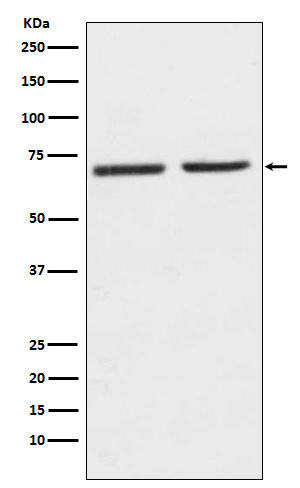5HT2C Receptor Rabbit mAb [oF8F]Cat NO.: A15176
Western blot(SDS PAGE) analysis of extracts from (1) SH-SY5Y cell lysate; (2) Mouse kidney lysate.Using 5HT2C Receptor Rabbit mAb [oF8F]at dilution of 1:1000 incubated at 4℃ over night.
Product information
Protein names :5-HT-1C; 5-HT-2C; 5-HT1C; 5-HT2C; 5-HTR2C; 5HT1C; 5HT2C; 5HTR2C;5Hydroxytryptamine 2C receptor; Htr1c; HTR2C;
UniProtID :P28335
MASS(da) :51,805
MW(kDa) :52kDa
Form :Liquid
Purification :Affinity-chromatography
Host :Rabbit
Isotype : IgG
sensitivity :Endogenous
Reactivity :Human,Mouse,Rat
- ApplicationDilution
- 免疫印迹(WB)1:1000-2000
- The optimal dilutions should be determined by the end user
Specificity :Antibody is produced by immunizing animals with A synthesized peptide derived from human 5HT2C Receptor
Storage :Antibody store in 10 mM PBS, 0.5mg/ml BSA, 50% glycerol. Shipped at 4°C. Store at-20°C or -80°C. Products are valid for one natural year of receipt.Avoid repeated freeze / thaw cycles.
WB Positive detected :(1) SH-SY5Y cell lysate; (2) Mouse kidney lysate.
Function : G-protein coupled receptor for 5-hydroxytryptamine (serotonin). Also functions as a receptor for various drugs and psychoactive substances, including ergot alkaloid derivatives, 1-2,5,-dimethoxy-4-iodophenyl-2-aminopropane (DOI) and lysergic acid diethylamide (LSD). Ligand binding causes a conformation change that triggers signaling via guanine nucleotide-binding proteins (G proteins) and modulates the activity of down-stream effectors. Beta-arrestin family members inhibit signaling via G proteins and mediate activation of alternative signaling pathways. Signaling activates a phosphatidylinositol-calcium second messenger system that modulates the activity of phosphatidylinositol 3-kinase and down-stream signaling cascades and promotes the release of Ca(2+) ions from intracellular stores. Regulates neuronal activity via the activation of short transient receptor potential calcium channels in the brain, and thereby modulates the activation of pro-opiomelacortin neurons and the release of CRH that then regulates the release of corticosterone. Plays a role in the regulation of appetite and eating behavior, responses to anxiogenic stimuli and stress. Plays a role in insulin sensitivity and glucose homeostasis..
Tissue specificity :Detected in brain..
Subcellular locationi :Cell membrane,Multi-pass membrane protein.
IMPORTANT: For western blots, incubate membrane with diluted primary antibody in 1% w/v BSA, 1X TBST at 4°C overnight.


